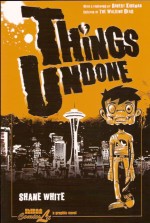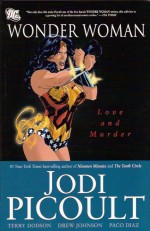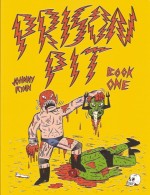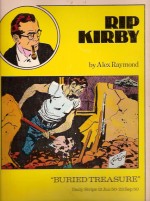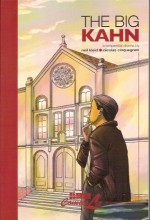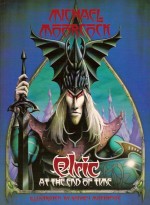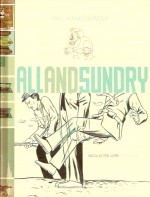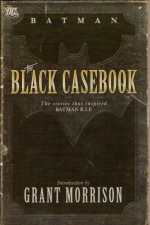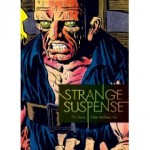
By Steve Ditko and various (Fantagraphics Books)
ISBN: 978-1-60669-289-0
¡Perfect Christmas Present Alert! – For the discerning comics fan
Steve Ditko is one of our industry’s greatest talents and probably America’s least lauded. His fervent desire to just get on with his job and to tell stories the best way he can, whilst the noblest of aspirations, will always be a minor consideration to commercial interests that for so long controlled comics production. So it’s a sublime joy to be able to look at his work from a more innocent time when he was just breaking into the industry, relentlessly honing his craft with genre tales for whichever publisher would have him, unrestricted by censors or intrusive editors.
This superb full colour hardback collection reprints his early works (all of them from the period 1953-1955) comprising stories produced before the draconian and self-inflicted Comics Code Authority sanitised the industry, and although most are wonderfully baroque and bizarre horror stories there are also examples of Romance, Westerns, Crime, Humour and of course his utterly unique Science Fiction tales, cunningly presented in the order he sold them and not the more logical but far less revealing chronological release dates. Sadly there’s no indication of how many (if any) were actually written by the moody master…
Ditko’s first strip sale was held for a few months and printed in Fantastic Fears #5 (published by Ajax/Farrell with a cover-date of January-February 1954); a creepy, pithy tale entitled ‘Stretching Things’, followed here by ‘Paper Romance’ an eye-catching if anodyne tale from Daring Love #1 (September 1953, Gilmor) and a couple of captivating chillers from Simon and Kirby’s Prize Comics hot horror hit Black Magic. ‘A Hole in his Head’ (#27, November-December 1953) combined psycho-drama and time travel whilst the more traditional ‘Buried Alive’ (#28 January-February 1954) was a self-explanatory gothic tale drama.
Stylish cowboy hero the Utah Kid stopped a ‘Range War’ in Blazing Western #1 (January 1954, Timor), and the artist’s long association with Charlton Comics began with the cover and vampire shocker ‘Cinderella’ from The Thing #12 (February 1954). The remainder of the work here was published by Charlton, a small company with few demands.
Their diffident attitude to work was ignore the creative staff as long as they deliver on time: a huge bonus for Ditko, still studiously perfecting his craft and never happy to play office politics. They gave him all the work he could handle and let him do it his way…
After the cover for This Magazine is Haunted #16, (March 1954) comes ‘Killer on the Loose’ a cop story from Crime and Justice #18 (April 1954), and the same month saw him produce the cover and three stories for The Thing #13, ‘Library of Horror’, ‘Die Laughing’ and ‘Avery and the Goblins’. From Space Adventures #10 (Spring 1954) comes the cover and the witty cautionary tale ‘Homecoming’, followed by three tales and a cover from the succeeding issue: ‘You are the Jury’, ‘Moment of Decision’ and the superbly manic ‘Dead Reckoning’.
This Magazine is Haunted #17, (May 1954), again featured a Ditko cover and three spooky tales ‘3-D Disaster, Doom, Death’, ‘Triple Header’ and the intriguingly experimental ‘The Night People.’ That same month he drew the cover and both ‘What was in Sam Dora’s Box?’ and ‘Dead Right’ for mystery title Strange Suspense Stories #18.
He got another shot at gangsters in the licensed title Racket Squad in Action (#11, May-June 1954) producing the cover and stylish caper thriller ‘Botticelli of the Bangtails’ and honed his scaring skills with the cover and four yarns for The Thing #14 (June 1954): ‘Rumpelstiltskin’, ‘The Evil Eye’, the utterly macabre ‘Doom in the Air’ and grisly shocker ‘Inheritance!’
He produced another incredible cover and five stories for the next issue, and as always was clearly still searching for the ultimate in storytelling perfection. ‘The Worm Turns’, ‘Day of Reckoning’, ‘Come Back’, ‘If Looks could Kill’ and ‘Family Mix-up’ range from giant monster yarns to period ghost stories to modern murder black comedies , but throughout, although all clearly by the same artist, no two tales are rendered the same way. Here was a true creator pushing himself to the limit.
He drew the cover and ‘Bridegroom, Come Back’ for This Magazine is Haunted #18, (July 1954), ‘A Nice Quiet Place’ and the cover of Strange Suspense Stories #19, plus the incredible covers of Space Adventures #12 and Racket Squad in Action #11 as well as the cover and two full stories in Strange Suspense Stories #20 (August 1954), ‘The Payoff’ and ‘Von Mohl Vs. The Ants’, but it was clear that his astonishing virtuosity was almost wasted on interior storytelling.
His incredible cover art was compelling and powerful and even the normally laissez-faire Charlton management must have exerted some pressure to keep him producing eye catching visuals that would sell their weakest titles. Presented next are the mind-boggling covers for This Magazine is Haunted #19 (August 1954), Strange Suspense Stories #22 and The Thing #17 (both November 1954) and This Magazine is Haunted #21, (December1954).
The Comics Code Authority began judging comics material from October 26th 1954, by which time Ditko’s output had practically halted. He had contracted tuberculosis and was forced to return to his family in Johnstown, Pennsylvania, until the middle of 1955. From that return to work come the final Ditko Delights in this volume: the cover and a story which originally appeared in Charlton’s Mad Magazine knockoff From Here to Insanity (#10, June 1955). A trifle wordy by modern standards ‘Car Show’ nevertheless displays the sharp, cynical wit and contained comedic energy that made so many Spider-Man/Jonah Jameson confrontations an unforgettable treat a decade later…
This is a cracking collection in its own right but as an examination of one of the art-form’s greatest stylists it is also an invaluable insight into the very nature of comics. This is a book true fans would happily kill or die for…
This edition © 2009 Fantagraphics Books. All Rights Reserved
